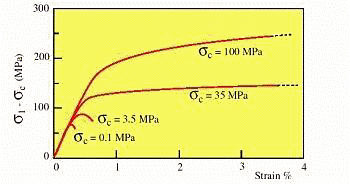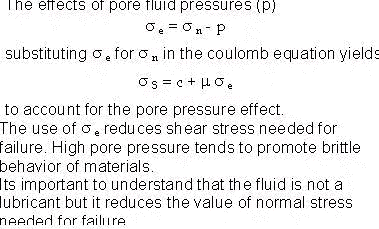ROCK DEFORMATION, CONFINING PRESSURE
If confining pressure is increased during the experiments, it makes the specimen stronger and requires a higher value of axial load to deform it. In other words, increasing confined pressure or Pconf has an effect of increasing the value of yield stress and the specimen has an overall increase in its strength, all the other variables being constant. The figure shows that when Pconf = .1 MPA, the value of yield stress (given in terms of flow stress or differential stress) is 70 MPA. If Pconf is increased to 3.5 MPA, the yield stress (same units) increases to 80 MPA. At Pconf=35 MPA, the yield stress increases to 120 MPA and finally at Pconf=100 MPA, the yield stress is of the order of 165 MPA.

ROCK DEFORMATION, PORE FLUID PRESSURE
The top figure shows the results of study did by N J Price on two sandstones, the Penant sandstone of early Palaeozoic age having 3.5 % porosity and Carboniferous Darly Dale sandtone having 20% porosity. When Pennant sandstone is soaked in water till it becomes constant in weight, nearly all of its 3.5% voids are filled with water. The compressie strength when it is entirely impregnated is 25000 psi. When this sanstone is made air dry, 50% of its 3.5% voids remain filled with water. The compressive strength of the rock in this condition, is 31000 psi. Finally when the rock is made oven dry till its weight becomes constant, 5% of its 35% voids still contain water but the rock can be said to be practically dry. The compressive strength under this condition is 54000 psi. This proves that as the rock becomes progressively drier, its compressive strength increases, yield stress also increases and the rock may fail at very high loads unless the other variables such as temperature or Pconf are allowed to change or the rate of strain.
In contrast, Darly Dale sandstone is much more porous, has 20% voids. When the specimen is impregnated till weight becomes constant, the rock has 40% of its 20% pores filled with water and the compressive strength is as low as 1000 psi. When the specimen is made air dry, only 22% of its voids are filled with water and the compressive strength is 13000 psi. When the specimen is made oven dry, it has only 5% of its 20% voids filled up with water and the value of compressive strength increases to 30000 psi. These studies show that the water content maker the rock weaker. Or it gets hydraulically weakened. The lower figure shows that if the temperature is increased then the yield stress decreases and the rock gets weakened. At very high temperatures, the rock may flow plastically on application of axial load and the elastic range gets considerably reduced.

ROCK DEFORMATION, STRAIN RATE
Natural deformations are very slow and to study the effect of strain rate on rock behaviour, the influence of strain rate shows that as the strain rate increases, so does the yield stress. In other words, if the rock is allowed to deform quickly, its yield stress is high and the elastic range is large. On the other hand, if the strain rate is low and the rock is allowed to deform slowly, then the yield stress gets reduced and the rock behaves plastically. The two figures show a comparative overview that under the same temperature, the decrease in strain rate decreases yield stress. The figure at bottom shows the same but under the condition of other variables being the same.
ROCK DEFORMATION, TEMPERATURE
Temperature can have two effects on brittle fracture. An increase in temperature lowers the von Mises yield stress for ductile behavior. This lowers the pressure of brittle - ductile transition and reduces the field of brittle behavior for materials. In addition, some experiments suggest that there is also a small decrease in the brittle shear strength with increasing temperature. The general behaviour is to decrease the modulus of elasticity and make the rock become either more viscous and ductile or make it more plastic, the response being plasticoelastic with limited elastic range. The yield stress gets lowered as does the ultimate strength.
STRAIN HARDENING
For deformation to continue you need to raise the stress applied as the material work hardens and needs more stress to induce weak planes, lines, points etc. (quite in contrast to softening in which case, the deformation continues despite stress value at constant point and even decreased since other factors such as temperature and chemical gradients established keep doing the job of deforming further independent of the stress as in ductile shear zones